DESPITE THE DESERT HEAT, INFOCOMM 08 IN LAS VEGAS HAD A LOT OF COOL OFFERINGS. HERE ARE SOME OF THE HIGHLIGHTS OF SHOW.
by Mark Mayfield
Each year, InfoComm International's U.S.-based annual conference and exhibition has become "the place to be" in June if you have anything to do with audio or audiovisual technologies. This year was no exception, especially with the added attractions of the NSCA Expo and the co-location with NXTcomm - both clear manifestations of the continuing evolution and convergence of our industries.
Yes, InfoComm 08 had a little bit of everything - record number of attendees, exhibitors, and educational opportunities. Record heat? Recession? What recession? The high cost of fuel? Judging from the activity in both the North and Central Halls of the Las Vegas Convention Center, it did not look like there was any slowdown in the AV industry. Most booths experience a steady flow of traffic, and educational sessions were well attended too - and the numbers support this.
According to InfoComm's numbers, there were nearly 35,000 attendees at this year's event, a 9.5 percent increase over the 2007 event. The number of exhibitors increased, too, by about 15 percent to a total of 988 companies showing their AV/IT products and system. Plus, registrations for InfoComm Academy educational courses totaled 8,606 for 2008.
One group was less well represented though. Despite the colocation with the NXTcomm, we didn't see many visitors from the "ecosystem of voice, video, and data" in the South Hall. This wasn't totally unexpected though, since even before the show, the idea behind the co-location seemed to make more sense to the AV-types than it did to the IT/telecom types.
In keeping with the maturing of the AV industry, most of the new products on display were really feature enhancements and functional improvements. There were, however, some exciting things happening in the exhibits halls, and AV Technology editors and collaborators compared notes to highlight some of them.
BREAKTHROUGHS IN PROJECTION AND IMAGING
If three is good, then four must be better, right? SANYO introduced its new PLC-XP200L 4LCD projector, and judging by its demo, a noticeable improvement in color is the result. According to Sanyo, as brightness levels increase on 3LCD projectors, there is a reverse effect in color reproduction. Colors become noticeably washed out, lacking vibrancy and realism. By adding a fourth LCD panel for color control of yellow, they claim to be able to automatically control the amount of yellow light in the image, producing higher luminosity with improved color accuracy and clarity. And because this fourth panel is able to take advantage of the yellow light produced by UHP lamps (rather than filtering it out and letting the RGB components create yellow), they are able to get a brighter image with high contrast. The PLCXP200L, the first projector to benefit from this new technology, is rated at 7,000 lumens. Coupled with the impressive high contrast ratio of 2200:1, the company claims that the PLC-XP200L is capable of generating clearer, richer, and more beautiful images than was ever possible with high brightness 3LCD projectors.
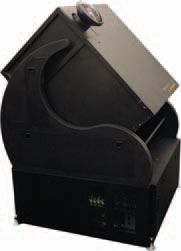
One of the most innovative collaborations at InfoComm was related to the current industry obsession with digital signage. Digital signage is a product application that could be used in virtually every vertical market. For many potential customers, one of the impediments to its mass acceptance has been the lack of a clear way to quantify and verify the investment. That may be changing. CAPITAL NETWORKS and COGNOVISION have teamed up to offer a complete tracking platform that includes Capital Vision's Audience content creation, scheduling, and management software and CognoVision's AIM (Anonymous Impression Metric) audience measurement system. AIM has been optimized for use in digital signage networks, and it uses proprietary face detection and tracking technology to find viewers' faces captured by digital optic devices. The company claims that AIM can provide business intelligence that allows you to track the number and duration of impressions and certain demographics of a digital signage installation's audience (gender and age bracket). Sounds a little scary, but CognoVision insists that the AIM system is designed to ensure that the data detected and aggregated cannot be associated or otherwise linked with any specific individual.
What's the number one complaint among projector owners and users? The lamps burn out and are expensive to replace. With new technologies on the horizon like LED and laser light sources, a solution may finally be near. TEXAS INSTRUMENTS demonstrated a prototype of the industry's first "lamp-free" projector that utilizes a PhlatLight LED light source and TI's BrilliantColor chipset. The result is a bright (700 lumens) 1080p image that eliminates maintenance costs such as lamp replacements and filter changes. PhlatLight LED-based projectors have been previously developed and commercialized, but until today brightness has limited their use to lower brightness ultra-portable pocket projectors. The significance of this breakthrough is that it creates the first lamp-free projector for mainstream applications that delivers all the color and performance advantages without compromising brightness. The solid-state, lamp-free innovation will first be incorporated into home theater units and proliferate through corporate and education product lines thereafter.
Speaking of new projection light sources, EVANS & SUTHERLAND debuted a new laser projection system featuring NanoPixel technology, called ESLP. It's claimed to be the world's highest resolution laser projector, targeted at digital cinemas, planetariums, control rooms, and other indoor venues. The ESLP takes advantage of the nanopixel light modulator, which is a MEMS (microelectromechanical system) device fabricated on a silicon microchip. On this chip are thousands of moving reflective elements arranged in a line array. This array corresponds to an entire column of pixels on the display (up to 4,096), and thereby allows all of those pixels to be drawn simultaneously. By sweeping an entire column of light across all pixel rows of the image, the system can achieve unprecedented levels of resolution. The only moving mechanical part in the optical path is a horizontal scan mirror that operates at a very stable 60 to 120 Hz refresh frequency. It is powered by a set of laser light sources that yield a much wider useable color spectrum (200 percent of NTSC/HDTV) than is available in conventional LCoS, DLP, LCD, or other lamp-illuminated projectors, according to the company.
A trend that we saw last year at InfoComm was more in evidence this year is the transition to widescreen projection formats - first 16:9, now 16:10. One prominent example of this is the new CANON REALiS WUX10. The company claims this to be the world's first WUXGA-resolution (1920 x 1200) widescreen projector using LCOS (Liquid Crystal on Silicon) technology. What's even more interesting is its new commitment to LCOS, since this is the first projector where it is using its own LCOS panels, instead of sourcing them from JVC. The REALiS WUX10 incorporates a 0.71-inch panel. Rated at 3,200 lumens of brightness and with a contrast ratio of 1,000:1, the AISYS-enhanced WUX10 multimedia projector can project full and precise display of photographs, intricate spreadsheets with small text, CAD drawings, and full-motion HD or SD video, all for a suggested list price of $12,999.
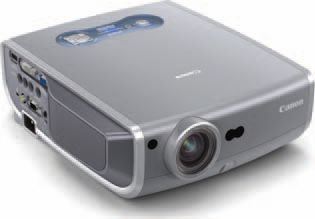
INFOCUS launched three new series of projectors, each with a set of interesting new features, but perhaps the most significant one is the use of DisplayLink connectivity.
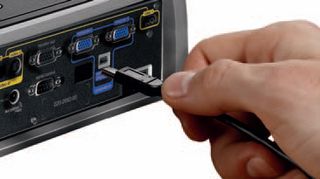
DisplayLink is a USB 2.0 technology that simplifies PC-to-projector interconnection and minimizes the "fear factor" that some non-technical end-users might experience fumbling with VGA connectors. DisplayLink for projectors is an industry first and is available only for the new InFocus 1100 and 3100 series projectors.
NOT ALL QUIET ON THE AUDIO FRONT
True, audio technology has a considerably longer history than video technology, and as the elder sibling of the AV world, it's understandable that there aren't a lot of breakthroughs to report from this year's InfoComm.
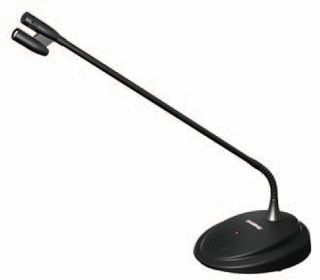
- But we did see some things worth noting.
SABINE's new Phantom gooseneck microphones includes some fancy new built-in processing that's going to make life a lot easier for technology managers who are responsible for audio systems used by inexperienced microphone users. The new 45-Series features Sabine's Phantom Mic Rider Pro inline mic processor,which includes automatic gain control (AGC), plosive/proximity effect control, and the infrared gate. The AGC maintains the gain so both the big and small voice presenters will get the proper output level without having to adjust the mic. As a person gets closer to the mic those annoying pops and increased boominess are minimized so the frequency response of the mic is consistent over a wide range of distances from the mic. Plus, the integrated infrared sensor automatically activates the mic based on the presence of a person in front of the microphone. The gate is adjustable - users can program the time to turn off the mic after a person walks away from the mic and how close to the mic a person must get before triggering the mic to turn on. This is a powerful feature - no more missing those cues when someone comes to the lectern for unexpected announcements. The sensor detects body heat and will not be fooled by stage curtains moving or chairs being placed in front of it. For less demanding requirement, Sabine also announced the 40-Series, which includes only the infrared gate.
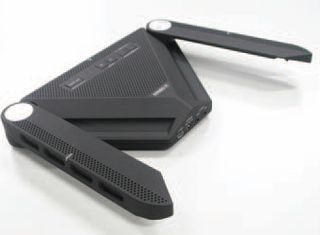
YAMAHA, a well-known brand in pro and commercial audio, has made a major commitment to teleconferencing with its new ProjectPhone series of products. The PJP-300 is a camera/microphone/ speaker all-in-one module for videoconferencing. It features automatic camera switching based on voice detection and includes adaptive echo cancellation for full-duplex communication. The PJP-VC1 is an IP videoconference codec that supports standard H.323 protocol and SIP. There's also an audioconferencing system (PJP-50R IP) with 16 microphones and four loudspeakers. Our favorite, however, is the collapsible PJP-25UR PC conference microphone/loudspeaker. The USB-powered device features movable microphone arms that adapt to various seating arrangements. By moving the microphone arms to change the pick-up pattern, conference participants' voices are picked up and transmitted clearly even in locations with some degree of ambient noise such as smallspaces in offices.










